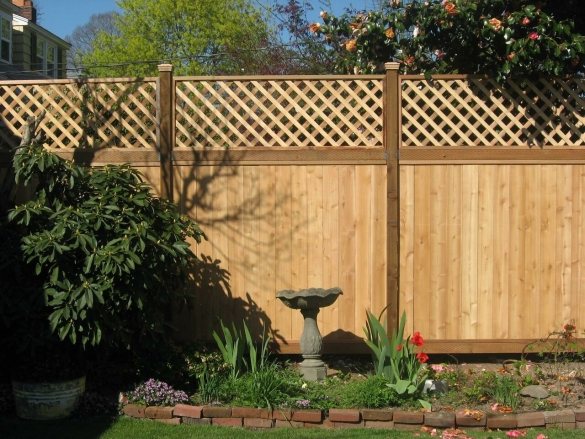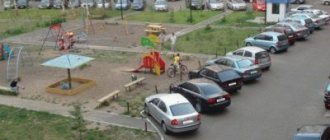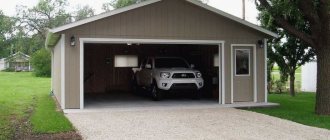Snip fencing territory fence
The material for the fence, when constructing fences on the main streets of populated areas, requires mandatory approval from local authorities. Often this requirement is ignored, but if other standards are met, then no additional problems arise. The maximum fence height is 2.2 m from the street and public areas.
This requirement is determined by the lighting standards of streets, driveways, and sidewalks. Also, the material from which the fence is constructed should not be potentially hazardous, i.e. Accidental contact with your fence should not in any way affect the health of a passerby or his property. The main examples of potentially hazardous materials: barbed wire, unplaned boards, etc. Gates should open inward if the roadway is less than 1.5 meters away. This is necessary so as not to interfere with traffic.
The fence separating areas between neighbors should also not exceed 2.2 meters , but there are significant restrictions:
- It is allowed to erect a so-called living fence - from bushes, trees, bindweed, etc. no higher than 1.5 meters in agreement with neighbors.
- Translucent fences are allowed to be installed: fences made of chain-link mesh, metal or wooden picket fences, forged or metal sections with a light transmittance of at least 50%.
- The height cannot exceed 0.75 meters if the fence is “solid”. These types of fencing include a fence made of corrugated sheets, a brick wall or a reinforced concrete fence.
- On the boundary line, without the consent of neighbors, you cannot install a fence more than 0.5 meters wide. Such fencing is permitted within one's own area.
With the consent of the neighbors, it is possible to install a fence between plots of more than 0.75 meters. Consent must be recorded in writing.
A combined fence up to 2.2 meters does not require approval from neighbors. This is 0.75 meters of “blind” fencing with the installation of a translucent fence on it.
Even when installing an approved “blind” fence, up to 2.2 meters high, it is necessary to ensure water drainage. If flooding occurs (rain, snow melting) of the neighbors' property as a result of the installation of this fence, they can quite legally demand the dismantling of the fence.
The basic rule when erecting a fence with your own hands is one: common sense. The neighbors will not be happy with your windows closed by your fence, the greenhouse darkened most of the time, or the knocking noise from poorly secured sheets. In such cases, you are guaranteed claims.
To request the removal of a fence installed without your consent, you will need to prove that it causes damage or harm.
What is the optimal fence height?
The fence on the site from the driveway (street) side can reach 2.2 meters and higher (only by decision of the general meeting of the gardening association).
Fences between adjacent areas can be erected no more than 1.5 meters high and only lattice. The fence between neighbors should transmit 50 percent of the light incident at an oblique angle. This requirement is determined by the light standards necessary for plant growth.
What materials to use to build a fence on the street side depends solely on your preferences and financial capabilities. Sites are most often demarcated by fences made of corrugated sheets - because the price of the materials required for their construction is the most optimal in terms of price-quality ratio.
When installing a fence, it is also necessary to take into account the standards regulated by local authorities. The height of fences may differ significantly from building codes. SNiP prescribes the correct arrangement of the territory.
Based on the experience of selling fencing materials, we can state that in most cases, buyers purchase corrugated sheeting with a height of 1.8 meters to delimit areas between neighbors and a height of 2 meters for installation on the street side.
How SNIP regulates the construction of fences
Fences around a site are the same construction object as, say, a residential building or outbuilding. And in the same way they are regulated by relevant requirements.
In the Russian Federation, the size and structure of the fence is regulated by SNiP for fences.
Corrugated fence
Classification
Fences are distinguished depending on the purpose, or more accurately, the characteristics of the object. Obviously, the requirements for a fence around an airfield and a playground are completely different.
On the territory of dacha associations, plot owners are faced with two types of fences:
- external - separating the site from the road or passage,
- between neighbors - that is, located on the boundaries between two neighboring plots.
SNiP for fence installation clearly regulates their parameters. Violation of the requirements is fraught with administrative liability, a fine, or even dismantling of the fence without compensation for material losses.
Building codes for external fencing
SNiP are considered as a recommendation that must be taken into account during construction. This does not mean that its requirements are optional, but the ability of local administrations to develop their own standards based on generally accepted ones.
- According to SNiP, the height of the fence on the side of the street, driveway or square reaches 2.2 m. A large value is undesirable, as it will serve as an obstacle to normal evening street lighting.
- The external fencing can be solid - made of corrugated board, brick, concrete, and so on. The photo shows a sample.
- The design must comply with safety regulations and not pose a threat to passersby. For example, a lattice option with peaks in the form of peaks is allowed if the sharp peaks are directed strictly vertical. If the peaks are directed towards the sidewalk, this is a violation. For the same reasons, barbed wire or untreated wood surfaces at human height are not allowed.
- Installing a fence involves draining rain and storm water. To do this, the strip foundation involves laying drainage pipes or arches. When using a non-continuous foundation, such problems do not arise.
- If an entrance is provided from the street side - a wicket door, a gate, then if the distance to the sidewalk is less than 1.5 m, the gate should open inward so as not to interfere with pedestrians.
No. 1. Criteria for choosing the type of fencing
Fencing is assigned a number of tasks , among which the main ones are :
- defining boundaries;
- ensuring the security of the territory;
- site decoration.
Each fence, to one degree or another, performs these functions, but since the dacha plot borders on different objects, some fences will perform these tasks to a greater or lesser extent. For example, a fence that separates a site from a street , road or forest must, first of all, be reliable and provide protection, while a fence separating your site from your neighbor’s serves mainly to define the border and decorate the territory - it is solid and impregnable doesn't have to be. In any case, the fence should be aesthetically pleasing and not spoil (or rather decorate) the suburban area.
The most important factor when choosing a fence material is the style of landscape design. For areas made in a classic style, the best decoration will be stone, brick or wrought iron fences, a country style will be decorated with a wooden fence, and in a folk style a wicker fence will be appropriate. It’s great if the fence, house and other buildings on the territory have some common features.

New and old SNiPs for summer cottage construction of fences in 2015
Before the construction of the fence begins, it is necessary to obtain permits, agree on the boundaries of the site in order to legalize its construction, and resolve all issues with the relevant government agencies.
In order to correctly prepare documents and sign the act in the local department of architecture, you need to study building codes, Federal laws, GOSTs. When erecting a fence, you must strictly follow the rules described in the documents provided.
Basic SNiPs that need to be taken into account when constructing fences
The current legislative framework strictly regulates the construction of a fence that is installed on a land plot. State bodies of Architecture and Land Management issue construction permits based on it. The main documents regulating the construction of fences, which contain requirements and restrictions, include:
- Construction norms and rules SNiP 30-02-97 “Planning and development of territories of gardening associations of citizens, buildings and structures”, approved by the Resolution of the State Committee of the Russian Federation on Housing and Construction Policy, adopted in 1997. The document provides the procedure for planning a land plot, provides recommendations for construction, and provides information about the distances separating the plot from other land plots and objects located on it. Changes were introduced to this SNiP in 2001.
- SP 11-106-97 “The procedure for the development, coordination, approval and composition of design and planning documentation for the development of territories of gardening associations of citizens,” which coordinates and resolves issues related to the process of developing design documents for individual construction.
The layout of the site includes the choice of the location of individual buildings in relation to the fence, so there is a need to comply with standards with maximum accuracy.
SNiP clarifies the following issues:
- choosing the optimal fence design,
- selection of suitable material,
- construction technology,
- parameters of the future fence, its optimal height,
- dimensions of distances to highways, between the house and the fence.
According to the requirements of SNiP, the fence must be installed three meters from the house , the fence must be 4 m away from outbuildings. There are also restrictions in relation to green spaces, for example, it must be located at a distance of 4 m from tall trees, and from shrubs - 1 m .
According to the conditions related to sanitary conditions, the distance to the border with the adjacent area should be equal to 1 m . The height of the fence should not be higher than 1 m so that the shadow does not fall on the neighboring area. This condition protects the legal rights of the neighbor.
Detailed information with examples about the distance between the fence and buildings is given in this article.
What should be the distance between neighbors' fences, and how it is regulated by law - read in this material.
If you are interested in how to make a fence from plastic bottles with your own hands, learn about it here.
Other important regulations
Supporting documents of significant importance include regulations, standards, and Federal laws, which include:
Let's sum it up
In areas owned by TSN, installation rules, height and other parameters of the fence are regulated by the organization’s Charter. The previously used SNiP 30-02-97 can be used as a guide, but the standards given in it are advisory in nature.
On the lands of individual housing construction and private plots, the rules regarding fences between neighbors may be regulated by local regulations. If a house in a village or forest stands alone, then there are no restrictions on the height and transparency of the fence. It is imperative to draw up an agreement between neighbors, and build the fence itself strictly along the border of the site.
Snip fencing territory fence
Many homeowners do not even realize how important it is to build a fence correctly and correctly position all the buildings and structures inside it until they encounter difficulties. After all, problems can arise both at the approval stage and at the operation stage, including with neighbors. That is why it is so important to know and comply with the existing norms and rules for the construction of fences, set out in the relevant regulatory documents.
The content of the article:
Sanitary standards for erecting a fence - determine the distance between fences according to the rules
SNiP 30-02-97 was developed for gardening plots . You should contact him if you have any questions. If the site is located in a rural area, then the answer can be found in SNiP 2.07.01-89. The stages of creation and approval of design documentation for the development of private property are regulated by the SP 11-106-97 standard.
So, the fence for gardening plots must be located along the border of your own plot, indicated in the owner’s documentation. But how to correctly arrange all the buildings, buildings and even plant trees and shrubs, you need to figure out before you start planning the landscaping of the site.
In order to properly organize the territory of a summer cottage, a number of environmental, hygienic, sanitary and household rules and norms must be observed . Particular attention should be paid to the section of the fence that is common with neighbors (adjacent), since all objects located near it, in one way or another, affect their property.
According to SNiP 30-02-97, site owners must maintain the following distances between objects during construction:
- Distances from the fence. The residential building must be located at a distance of at least three meters from the fence. Outbuildings with poultry and animals, as well as greenhouses, are allowed to be built at a distance of four meters from the border of the site. The garage and other outbuildings can be located a meter from the boundary. Sanitary facilities (including a bathhouse) should be no closer than three meters from the fence. There are also requirements for green spaces. Tall tree species must be planted at a distance of no closer than four meters from the fence, but medium-sized ones can only be separated by two meters. It is enough to step back just one meter from the border of the site in order to “legally” plant shrubs on your site. The main object on any summer cottage site, as a rule, is a residential building.
- Distances from a residential building. The toilet must be located no closer than twelve meters from the house. Other sanitary facilities (bathhouse, shower) can be erected eight meters from a residential building. Outbuildings for keeping animals should be located at a distance from the house and this distance cannot be less than fifteen meters. A distance of six meters is allowed between residential buildings.
Review of fire safety standards - installing a fence in accordance with the requirements
When planning a site, fire safety standards are also taken into account . SNiP specifies the distances between objects that prevent the spread of flame within one’s own and neighboring areas in the event of a fire in structures, buildings or green spaces. For example, it will be enough to build a house 3 meters from the neighbors’ fence to avoid the threat of fire in the event of a fire in a neighboring area.
Conclusion
How high the fence between plots is depends on their category; if a joint venture applies to SNT, then within populated areas all parameters are regulated by PZZ. Before building a fence, you should carefully study all the requirements; ignorance is never an excuse. In addition, you can agree on the type of fence and its design with neighbors and the administration (board), having everything documented to avoid problems in the future.

Read more about the distances between objects on the site in one of the previous materials. For example, here is a selection of court decisions on neighbor litigation, including on the issue of fences. In the video - a country wicker fence made by women's hands.
Subscribe to our Telegram channelExclusive posts every week









